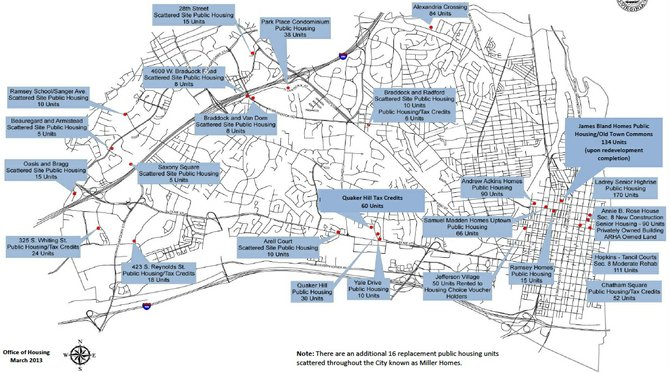Redeveloping ARHA
Ladrey Senior Highrise: 170 units
Hopkins-Tancil Courts: 111 units
Andrew Adkins: 90 units
Alexandria Crossing: 84 units
Samuel Madden Uptown: 66 units
Jefferson Village: 50 units
Uncertainty is hanging in the air for thousands of public-housing residents and their neighbors. That's because the Alexandria Redevelopment and Housing Authority is seeking feedback from developers about potential redevelopment of seven key properties — six housing developments as well as the organization's administrative office on North Fairfax Street. Together, the properties have 571 units. The request for proposals was issued by the authority in partnership with its affiliated development corporation, Virginia Housing Development.
"People who live in these units are concerned, as are people who live right outside of them because nobody knows what's going on," said Alexandria Councilman John Chapman. "Not having specifics is going to make people cautious and concerned."
Last month, the authority issued requests for proposals to developers who might be interested in redeveloping the properties. Then, last week, a series of developers joined authority leaders for a bus tour of the seven properties. Now the ball is in the court of the developers, who will be coming forward with plans to redevelop one or more of the sites by March 17. Their goal, according to the authority, is to deliver "mixed-income, mixed finance and/or mixed-use components."
"They've got to go through the approval process, and there has to be a plan to relocate and house all of our residents," said Christopher Ballard, former chairman of the authority. "Once we get responses back from the development community, we'll be able to better prioritize."
REDEVELOPMENT OF PUBLIC housing has been a source of ongoing controversy over the last decade. The trend began with the old Samuel Madden Downtown, a public-housing complex known locally as "the Berg" — a derivative of Petersburg, where many of the residents had roots. The public-housing complex was the childhood home of Alexandria Mayor Bill Euille and Police Chief Earl Cook, both of whom have streets named after them now that the property has been redeveloped into Chatham Square.
"It brought me to tears when they said they were naming a street in my honor," said Euille in 2004, when the streets were dedicated. "It's one thing to be mayor of this wonderful city. But it's quite another to have something so lasting named for you."
About half of the public-housing units at the Berg were replaced at Chatham Square. The rest were located in other parts of the city. More recently, the James Bland public-housing complex was demolished in the Parker Gray neighborhood. Once again, about half the units were replaced on site and the rest were scattered through other parts of the city. That's a strategy that could play out again at properties such as the Ladrey Senior Center or Hopkins-Tancil Courts, which are prime spots for redevelopment. Critics say this has decimated a once-thriving black community.
"This city once had a vibrant African-American community centered around the Berg and Ladrey and the northside projects, and now you have people scattered 10 units here and 10 units there," said Jon Liss, executive director of Tenants and Workers United. "Even when they live in the middle of the redeveloped Berg, they get harassed by their more affluent neighbors. So we've really seen a destruction of both affordable housing and a vibrant black community."
A CITY ORDINANCE known as Resolution 830 requires that all public-housing units that are destroyed be replaced, a one-for-one ratio that legally binds the city to find housing for all current residents. But that's a transition that is worrisome to some. When the first James Bland units were demolished, for example, many say they were not given timely notice. An advocacy group known as Virginians Organized for Interfaith Community Engagement worked with residents for more than a year to get moving expenses.
"In the first phase of James Bland, a lot of residents were very frustrated that they were asked to move in November and December," said Jennifer Knox, an organizer with VOICE. "That might have worked well for the developer, but it didn't work well for families — especially families with kids who would have to change school systems."
The juxtaposition of low-end residents and high-end townhouses is supposed to create a rising tide of opportunity, a theory supporters call "scattered site housing." The idea is that instead of concentrating public housing in one part of the city, it's spread out in different areas. Ideally, the concept is supposed to work both ways. Public-housing residents are supposed to learn from their market-rate neighbors and vice versa. Meanwhile, the persistent problems with crime caused by concentrating public-housing units in one place are supposed to disappear as the city adopts a new philosophy.
"There could be townhomes and condominiums and apartments, and so I don't think it will be one product type that we do hundreds of times that delivers at the exact same time," said Ballard. "The reality is that there will be a natural progression through the sites."
